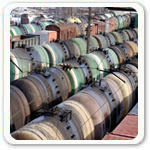Petroleum (L. petroleum, from Greek: petra (rock) + Latin: oleum (oil)[1]) or crude oil is a naturally occurring, flammable liquid consisting of a complex mixture of hydrocarbons of various molecular weights and other liquid organic compounds, that are found in geologic formations beneath the Earth's surface. Petroleum is recovered mostly through oil drilling. This latter stage comes after the studies of structural geology (at the reservoir scale), sedimentary basin analysis, reservoir characterization (mainly in terms of porosity and permeable structures).[2][3] It is refined and separated, most easily by boiling point, into a large number of consumer products, from petrol and kerosene to asphalt and chemical reagents used to make plastics and pharmaceuticals.[4] Petroleum is used in manufacturing a wide variety of materials
Proven world oil reserves, 2009
Etymology
The term petroleum was found (in the spelling "petraoleum") in 10th-century Old English sources.[5] It was used in the treatise De Natura Fossilium, published in 1546 by the German mineralogist Georg Bauer, also known as Georgius Agricola.[6] In the 19th century, the term petroleum was frequently used to refer to mineral oils produced by distillation from mined organic solids such as cannel coal (and later oil shale), and refined oils produced from them; in the United Kingdom, storage (and later transport) of these oils were regulated by a series of Petroleum Acts, from the Petroleum Act 1862 c. 66 onward.
Composition
In its strictest sense, petroleum includes only crude oil, but in common usage it includes all liquid, gaseous, and solid (e.g., paraffin) hydrocarbons. Under surface pressure and temperature conditions, lighter hydrocarbons methane, ethane, propane and butane occur as gases, while pentane and heavier ones are in the form of liquids or solids. However, in an underground oil reservoir the proportions of gas, liquid, and solid depend on subsurface conditions and on the phase diagram of the petroleum mixture.[7]
An oil well produces predominantly crude oil, with some natural gas dissolved in it. Because the pressure is lower at the surface than underground, some of the gas will come out of solution and be recovered (or burned) as associated gas or solution gas. A gas well produces predominantly natural gas. However, because the underground temperature and pressure are higher than at the surface, the gas may contain heavier hydrocarbons such as pentane, hexane, and heptane in the gaseous state. At surface conditions these will condense out of the gas to form natural gas condensate, often shortened to condensate. Condensate resembles petrol in appearance and is similar in composition to some volatile light crude oils.
The proportion of light hydrocarbons in the petroleum mixture varies greatly among different oil fields, ranging from as much as 97% by weight in the lighter oils to as little as 50% in the heavier oils and bitumens.
| Element | Percent range |
|---|
| Carbon | 83 to 87% |
| Hydrogen | 10 to 14% |
| Nitrogen | 0.1 to 2% |
| Oxygen | 0.05 to 1.5% |
| Sulfur | 0.05 to 6.0% |
| Metals | < 0.1% |
Crude oil varies greatly in appearance depending on its composition. It is usually black or dark brown (although it may be yellowish, reddish, or even greenish). In the reservoir it is usually found in association with
natural gas, which being lighter forms a gas cap over the petroleum, and
saline water which, being heavier than most forms of crude oil, generally sinks beneath it. Crude oil may also be found in semi-solid form mixed with sand and water, as in the
Athabasca oil sands in
Canada, where it is usually referred to as crude
bitumen. In Canada, bitumen is considered a sticky, black, tar-like form of crude oil which is so thick and heavy that it must be heated or diluted before it will flow.
[10] Venezuela also has large amounts of oil in the
Orinoco oil sands, although the hydrocarbons trapped in them are more fluid than in Canada and are usually called
extra heavy oil. These oil sands resources are called
unconventional oil to distinguish them from oil which can be extracted using traditional oil well methods. Between them, Canada and
Venezuela contain an estimated 3.6 trillion barrels (570
×10^9 m
3) of bitumen and extra-heavy oil, about twice the volume of the world's reserves of conventional oil.
[11]
Petroleum is used mostly, by volume, for producing
fuel oil and
petrol, both important
"primary energy" sources.
[12] 84% by volume of the hydrocarbons present in petroleum is converted into energy-rich fuels (petroleum-based fuels), including petrol, diesel, jet, heating, and other fuel oils, and
liquefied petroleum gas.
[13] The lighter grades of crude oil produce the best yields of these products, but as the world's reserves of light and medium oil are depleted,
oil refineries are increasingly having to process heavy oil and bitumen, and use more complex and expensive methods to produce the products required. Because heavier crude oils have too much carbon and not enough hydrogen, these processes generally involve removing carbon from or adding hydrogen to the molecules, and using
fluid catalytic cracking to convert the longer, more complex molecules in the oil to the shorter, simpler ones in the fuels.
Due to its high
energy density, easy
transportability and
relative abundance, oil has become the world's most important source of energy since the mid-1950s. Petroleum is also the raw material for many
chemical products, including
pharmaceuticals,
solvents,
fertilizers,
pesticides, and
plastics; the 16% not used for energy production is converted into these other materials. Petroleum is found in
porous rock formations in the upper
strata of some areas of the
Earth's
crust. There is also petroleum in
oil sands (tar sands). Known
oil reserves are typically estimated at around 190 km
3 (1.2
trillion (short scale) barrels) without oil sands,
[14] or 595 km
3 (3.74 trillion barrels) with oil sands.
[15] Consumption is currently around 84 million barrels (13.4
×10^6 m
3) per day, or 4.9 km
3 per year. Which in turn yields a remaining oil supply of only about 120 years, if current demand remain static.
Composition by weight
| Carbon | 83 to 87% |
| Hydrogen | 10 to 14% |
| Nitrogen | 0.1 to 2% |
| Oxygen | 0.05 to 1.5% |
| Sulfur | 0.05 to 6.0% |
| Metals | < 0.1% |






















